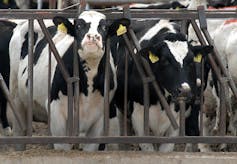This article was originally published on , which features includes relevant and informed articles, written by researchers and academics in their areas of expertise and edited by experienced journalists.
is a professor in food distribution and policy at ±«Óătv University.
In a nutshell, here is what happened : Justin Trudeau played nice with Donald Trump, Trump tore Trudeau apart on social media, Trudeau played nice again. While Trudeau showed very Canadian diplomacy, poise and resilience, the Canadian public seems to be taking another approach.
Everywhere on social media, Canadians — that is, to shop for groceries without buying a single American product.
Even by serving “Trump-free” dishes. These are interesting reactions in the face of Washington’s somewhat contradictory foreign trade policies.
The “Buy Canadian” campaign targeting food products is nothing new. We have shown our solidarity in the grocery store before. Canadians tend to rally to support specific sectors when they’re faced with adversity.
In 2003, in which the cattle industry took a $7 billion hit, Canadians showed their love for Canadian beef, so much so that Canada became the first country in the world after its first native mad cow case.

But this support was short-lived compared to the crisis itself, which lasted for more than two years. In this case, retail sales for beef in Canada remained high for about the first nine months, and then decreased steadily afterwards.
That’s because consumers have busy lives, fixed habits and, most importantly, specific budgets. Once the media had moved onto the next crisis, most people had already forgotten there had ever been a mad cow crisis in the first place.
Mad cow did lasting damage
Many Canadian farmers because of mad cow. But the public tends to react to things that are front of mind, and that affect them directly.
Trade disputes are notorious for their capacity to damage economies, affecting everyone involved. We trade for a reason. Some nations can produce certain goods at a lower price than others.
A nation’s competitive advantage can both develop its own economy and serve other economies in need of innovative products they can’t produce themselves for one reason or another.
With food, however, innovation is not nearly as big an issue as food security. Food systems operate with the premise of serving a budget-stretched consumer. Studies have shown , whether we realize it or not.
Food is temporary, and as such, cannot really help consumers impress a certain social class, perceptually speaking. Unlike durable products, consumers cannot show off their new jam, strawberries or freshly purchased chicken.
This is the nature of “cupboard economics.” People can visit a beautiful home but never see what’s kept inside the cupboards. At the restaurant, though, it’s different. Here, the “Buy Canadian” campaign is more fitting.
Buy Canadian as Canada Day approaches?
Patriotism ranks second to price. This is the ideal time of year to use patriotism to justify some of our retail purchases. As Canada Day approaches, more consumers will feel the urge to buy Canadian, and why not?
But here again, consumers are fickle and will opt for the product that offers the best quality for the lowest price. In other words, they will most often choose the lowest-priced item, regardless of country of origin.
But here’s another reality while consumers are on their quest to find Canadian products. The highly integrated nature of the U.S. and Canadian economies plays out on our grocery store shelves.
Many American food products have at least one Canadian ingredient, and vice versa. Defining what a Canadian product is can be tricky.
It’s hard to go Trump-free with processed foods
In the produce section, for example, it’s easy to choose Canadian items over American ones, since fruits and vegetables are clearly labelled as to country-of-origin.

It’s much less obvious with processed goods. Finding a maple leaf on the package is only half the battle. Many ingredients in packaged foods come from elsewhere, since current regulations only require Canadian manufactured food products to undergo the last stage of processing in Canada.
In short, if we want to be assured of buying Canadian, we should go out to eat Canadian more often, or buy fresh products in the grocery store.
![]() Kudos to those for Canadians willing to do so. However, if our trade war with the U.S. escalates, not only will we not have a choice in buying Canadian, it will also cost us a lot more to feed ourselves.
Kudos to those for Canadians willing to do so. However, if our trade war with the U.S. escalates, not only will we not have a choice in buying Canadian, it will also cost us a lot more to feed ourselves.
Read the on The Conversation.
±«Óătv University is a founding partner of The Conversation Canada, a new-to-Canada online media outlet providing independent, high-quality explanatory journalism. Originally established in Australia in 2011, it has had more than 85 commissioning editors and 30,000-plus academics register as contributors. A full list of articles written by ±«Óătv academics can be found on .

